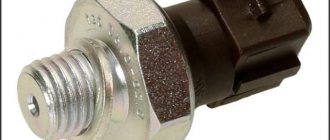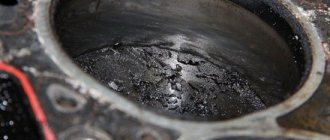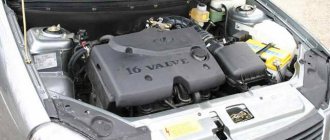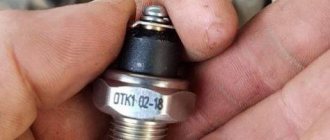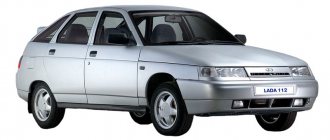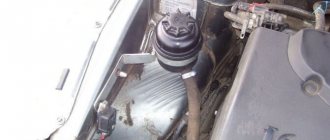- home
- Engine
- …
Nowadays, fewer and fewer cars are equipped with an engine oil pressure sensor, if you look at budget foreign cars - I don’t even remember which ones have it. However, now there are enough cars of previous generations on the market, but they had such a sensor. For example, on some VAZ, UAZ, VOLGA, etc. Many people ask the question - what oil pressure should be in the engine, that is, what is the normal value and what is not? It is not always possible to find information specifically about your model, so this article will be useful to everyone...
You know, now manufacturers are simplifying the dashboard of cars more and more, for example, on mine ( Chevrolet Aveo T300 ) there is no longer even an engine temperature sensor, I’m already silent about the oil pressure sensor. It turns out that the manufacturers want YOU to ruin your iron horse faster, because you cannot control all the necessary parameters, and accordingly, if you operate it incorrectly, you will quickly come running to them to repair it. All this can be attributed to a conspiracy by the manufacturers. Although now they say everywhere that cars have become more reliable, different materials are used, etc., but practice shows the opposite, three to five years and it’s better to change the car. Oh, there were times - there were cars, there was complete control over the engine.
Checking oil pressure
Recommendation
If, when the engine is warmed up to operating temperature and idling, the emergency oil pressure lamp lights up, you should make sure that:
a) the oil level in the engine sump is normal;
b) the engine is filled with oil in accordance with the factory operating instructions;
c) the oil pressure sensor is working and its wire is not shorted to ground. The integrity of the sensor wire insulation is checked visually. To check the sensor itself, replace it with a known good one and start the engine. If the control lamp continues to light, it means that the sensor is working;
d) there are no extraneous sounds coming from the engine (knocks, grinding noises) indicating cranking of the connecting rod or main bearings or a malfunction of the oil pump.
To complete the work you will need a pressure gauge.
Execution Sequence
1. We prepare the car for work.
2. Start the engine and warm it up to operating temperature.
3. After turning off the engine, remove the emergency oil pressure sensor.
4. Screw the tip of the pressure gauge into the mounting hole of the sensor.
5. Start the engine and check the oil pressure at idle speed at a crankshaft speed of about 5,400 min-1.
For a serviceable engine warmed up to operating temperature, the oil pressure at idle speed should be at least 196.2 kPa (2 bar), and the oil pressure at high crankshaft speed should be 441.3-637.4 kPa (4.5-6 .5 bar). If the pressure is below normal, then the engine needs major repairs. If the oil pressure is higher than normal at high engine speeds, the oil pump relief valve is probably faulty.
6. Upon completion of the test, install the sensor in place
Add a comment Cancel reply
You must be logged in to post a comment.
Source
Diagnostic features
Before replacing the old device, it must be removed and checked. The easiest way to check is to plug in a known-good device into the network.
Another way is to screw a pressure gauge in place of the sensor. If the tester shows a pressure of 0.65 kgf/cm2 or more, this indicates that the system has normal pressure and the cause is a faulty device.
If you don’t have a pressure gauge at hand, you can check the sensor in the following way:
- unscrew the regulator;
- crank the starter without starting the engine;
- If oil flows from the socket, then the sensor is faulty and needs to be replaced.
practical guide
Recommendation
If, when the engine is warmed up to operating temperature and idling, the emergency oil pressure lamp lights up, you should make sure that:
a) the oil level in the engine sump is normal;
b) the engine is filled with oil in accordance with the factory operating instructions;
c) the oil pressure sensor is working and its wire is not shorted to ground. The integrity of the sensor wire insulation is checked visually. To check the sensor itself, replace it with a known good one and start the engine. If the control lamp continues to light, it means that the sensor is working;
d) there are no extraneous sounds coming from the engine (knocks, grinding noises) indicating cranking of the connecting rod or main bearings or a malfunction of the oil pump.
To complete the work you will need a pressure gauge.
Execution Sequence
1. We prepare the car for work.
2. Start the engine and warm it up to operating temperature.
3. After turning off the engine, remove the emergency oil pressure sensor.
4. Screw the tip of the pressure gauge into the mounting hole of the sensor.
5. Start the engine and check the oil pressure at idle speed at a crankshaft speed of about 5,400 min-1.
For a serviceable engine warmed up to operating temperature, the oil pressure at idle speed should be at least 196.2 kPa (2 bar), and the oil pressure at high crankshaft speed should be 441.3-637.4 kPa (4.5-6 .5 bar). If the pressure is below normal, then the engine needs major repairs. If the oil pressure is higher than normal at high engine speeds, the oil pump relief valve is probably faulty.
6. Upon completion of the test, install the sensor in place
Add a comment Cancel reply
You must be logged in to post a comment.
Your vehicle's instrument cluster contains a warning light for low engine oil pressure. For reliable engine operation, it is necessary that the lubrication system maintain a sufficiently high pressure at all times.
Attention.
If the oil pressure warning light comes on while the engine is running and continues to light at increased speed, this is an alarming sign.
You need to immediately stop driving, stop the engine and find out the cause. Continued operation of the engine with low oil pressure can lead to serious engine damage and large financial costs for repairs. How to check the lubrication system?
1. Open the hood. Do not rush to immediately check the oil level in the engine; let it drain into the oil sump, this will take two to three minutes. During this time, carefully inspect the engine, find out if there are any fresh oil leaks on it.
2. Look under the front of the car to see if the engine oil sump is broken or leaking.
Recommendation.
If an oil leak is detected from a punctured oil sump, try to temporarily repair it in place. To do this, you can use a car inner tube, a piece of rubber, a rag, a wooden plug, etc. A good result can be obtained by using modern repair materials such as “cold welding”, available for sale in car dealerships.
3. Pay special attention to the oil filter. Oil may leak from under the rubber filter gasket if it is damaged or the filter is poorly secured. If oil is leaking from under the oil filter, sometimes it is enough to turn it a little clockwise.
Attention.
Be careful: hot engine parts can burn you, so wear gloves and long sleeves.
4. Remove the dipstick, wipe it with a clean cloth and reinsert it.
5. Remove the dipstick again and check the oil level. It should be between the top and bottom levels of the grid scale.
It is worth noting that in the previous article we looked at another malfunction when the Lada Priora engine stalls. Come in and you will find out what measures you need to take.
6. If the oil level is below the lower scale mark, add oil to the specified level.
Recommendation.
If you don't have a funnel to add oil, you can use a funnel made from the neck of a plastic bottle.
7. Start the engine. If, at a normal level, the emergency oil pressure drop lamp goes out, you can continue driving. If the lamp does not go out, check the serviceability of the oil pressure sensor. It is mounted at the top of the rear of the camshaft bearing housing. Unscrew the standard oil pressure sensor and install a mechanical pressure gauge in its place. If at normal idle speed the pressure is more than 0.1 MPa (1.0 kgf/cm2) and increases with increasing speed, the sensor or its electrical circuit is faulty.
Recommendation.
If you do not have a pressure gauge, all that remains is to check the reliability of the contact in the block with the sensor wires or replace the sensor with a known good one.
If, after eliminating all visible causes, the oil pressure in the engine is insufficient (the emergency oil pressure drop lamp is on), diagnose and repair the engine.
Attention.
Do not try to drive to the garage: the engine will fail.
Tow the vehicle with the engine not running for repairs. Recommendation.
Before you begin repairing the engine, check the condition of the oil pump.
Good evening, friends. There will be a lot of letters, I hope that someone who rummages around in cars will master my entire story and help with advice. Because I’m already tired of fighting our auto industry. It all started with the fact that I decided to buy myself a car. I had very little money, I’m quite a big man, I was looking for something, well, at least something more spacious for me. When choosing, I settled on the Prior. It looks ok, the repairs don’t seem to be particularly expensive, and, as I said, there wasn’t much money for the purchase. This is my first car in my life, I’m on good terms with cars, I don’t know how to choose. Having traveled around to outbid sellers, I inspected a couple of cars, three or five, I settled on a 2008 Priora 16 valve, the saffron milk caps don’t seem to be visible, the condition is good. I don’t have any friends who would go with me and buy a car, everyone has moved away, so I chose it myself. I checked that it went for a ride, looked at the light bulbs, checked that the handbrake worked, the power windows and windshield wipers worked, everything suited me and I decided I should take it. And took. The seller said, change the oil, guy, it hasn’t been changed for a long time, that’s all I know. I bought a car, drove it home, I don’t have a license, I added a colleague from work to my insurance, transferred the car to myself, and left it for him to drive while I got my license. I give him a car, and he is my personal driver. From home to work, from work home. I like. And he tells me, “Your oil pressure light is blinking, that’s not good.” I tell him that the seller warned that the oil needs to be changed, it’s old. I bought oil and an oil filter and were going to change it. And this guy, a colleague, still has a bit of a knack for cars, he studied to become an auto mechanic, and worked for some time in a service department for some friends. (You should have taken it with you, stupid) We were going to change the oil, we drained the old oil, but it was new. Well, it's clean. Well, what can you do, since you already bought the oil, let’s change it. Changed the oil and filter - nothing changed. Well, he offered to take the Priora to a service center, to see some friends, Uncle Misha, a great guy. When we arrived, he said we need to look at the oil pickup. The car is in the pit, Misha jumps in there, unscrews something there - a new oil pickup, the price is still on it. He says leave the car, we’ll sort it out. Oh, and I dragged out my story. As a result: I ended up with a full engine capital. Uncle Misha, a kind man, did everything for me at half price, but he immediately said that in his free time, at a discount, he overhauled the engine, the car sat in the service center for a couple of months, well, I’m not in a hurry. And when I picked up the car from the service center, Misha told me that your pressure is low, when hot, when idling, 0.8 kgf/cm2, when cold, the pressure is excellent. You need to change the oil pump, buy it and we’ll replace it for you. I don’t have much money, I picked up the car from the service center, drove it 3,000 km, bought an oil pump, all the gaskets, well, everything I needed, what Misha said, I took the car and waited. As it turned out, it was in vain. After changing the oil pump, the pressure did not change. As it was, so it remains. I re-read all the forums that I found, opinions are divided, my head is already spinning, I wrote to all my friends who understand at least something about this, but nothing helps. Please give me some advice, has anyone encountered this? Who knows where the trouble lies? How can I increase the pressure from idle to hot to at least 1.5? Don’t heat it too much, please, friends, I’ll leave a couple of comments for the cons. I hope for the power of Peekaboo!
Video
The gearbox oil should be changed every 30,000-40,000 km - if you have a manual gearbox, and 50,000-60,000 km if you have an automatic transmission. In my case, the rear gear crunching was heard and the second gear began to work hard. The dipstick showed the oil level at a minimum, although it should be between the minimum and maximum stripes. If it is below the minimum, then you should think about changing it, otherwise the parts will wear out and crumble. Choice of oil? Which one should I fill? Let's see what the manufacturer advises us:
Many people use ZIC oil (made in Korea) and other oils. Although it costs a little more, I didn’t see the point in overpaying. Now let’s look at the labeling. SAE class and winter-summer temperature range (in °C): 75w-80 – from -40 to +35° C; 75w-90 – from -40 to +35° C; 80w-85 – from -26 to + 35° C; 80w-90 – from -12 to +45° C. Here transmission lubricants were classified by quality. The letters indicate the quality and area of use of the oil, and the numbers indicate the temperature regime. The temperature limits when using synthetics increase. Since my region is northern, my temperature range ranges from -40 to +35, then either 75w-80 or 75w-90 is suitable for me. Mineral lubricants do not have this feature. When lubricants are used in the transmission, fluctuations in the physical composition begin. Oxidation of a mineral base occurs faster than a synthetic base. For this reason, the mineral base ages faster. Mineral lubricant is changed more often. Transmission devices will wear differently. So we take either semi-synthetic or synthetic, whichever you can afford. I took semi-synthetic gear oil from Rosneft 75w 90 GL4/5 with a volume of 4 liters.
What you need for work: 1. Open-end wrench size 17 (socket wrench is most convenient). Price: 125 rubles (420 tenge)2. Funnel and hose 1.0-1.5 m long (for filling oil). Price: 125 rubles (420 tenge)3. Jack (or inspection hole/overpass).4. Empty container for draining old oil (3-4 liters).5. Gear oil 4 liters. Price: 1150 rub (3900 tenge)
Before draining the oil from the gearbox, you need to warm it up. You either need to drive for 15 minutes or drive 5-10 km. Then, within 15 minutes while the oil is hot, you need to drain it. Warming up the car on the spot will not help, you definitely need to drive it. Just in case, I put the car in first gear and the handbrake. Jacked up the front wheel on the driver's side. I tightened the bolt with a 17mm wrench. I washed the bolt (so that I could insert a clean one later). I placed an empty container to drain the oil. The pressure was low and oil was poured into the protection. It’s most convenient, of course, to first remove the protection before draining the oil; I was too lazy to tighten a bunch of screws. I lowered the car from the jack and left it standing there for 30-40 minutes. Around the 20th minute, I took it off the program.
Then he jacked it up again and tightened the bolt. I wiped everything around the bolt that I was tightening with a dry rag in order to track any possible leaks, and poured oil through a hose with a funnel. After filling 3 liters, I began to periodically check the oil level with a dipstick. It took about 3.7-3.8 liters of oil. You need to fill in a little more than the strip at maximum so that the fifth gear does not dry out. I wiped the dirt off the dipstick with water and put it in place. I got into the car and started turning the gears 3-5 times, so that the oil would seep out normally everywhere. After this procedure, the box began to work softer and the sounds became less.
Purpose of the oil pressure sensor
The main purpose of the oil pressure sensor on a Lada Priora with an 8 or 16 valve engine is to emergency inform the driver about a critical decrease in the monitored parameter. This allows you to prevent the engine from operating with oil starvation, which can significantly reduce the life of the power plant.
The oil pressure sensor has a membrane in its design. Its deformation is related to the external influence of the lubricant. As soon as the oil pressure drops below the permissible level, the alarm indicator control circuit is closed. After it catches fire, it is extremely undesirable to continue driving without identifying and eliminating the cause, as this can significantly affect the service life of the motor.
What you need to know about DDM?
The regulator in question is an important element of the lubrication system of the Lada Priora car, equipped with an electronic control unit (video author – SoftFelix).
Purpose and location
The indicator is designed to warn the driver of insufficient oil pressure. It is located on the engine cylinder head near the oil filter under the exhaust manifold. To carry out diagnostics, the device must be removed.
Location in the engine compartment
The operating principle of the device is simple. Under pressure, the membrane gasket bends and changes its shape. It acts on contacts that close or open.
Device operation diagram
Typical malfunctions and methods for their elimination
If the oil pressure warning light does not come on when the ignition key is in the “on” position, the following malfunctions are possible:
- broken wiring;
- the light bulb burned out;
- the regulator is faulty;
- bad contact.
A broken wire is looked for using a test light and repaired by replacing the damaged wire. The burnt out light bulb is replaced with a new one. To eliminate the cause of poor contact, you need to clean the connections and check the reliability of the wire connections. A faulty regulator should be replaced.
DDM on Lada Priora
Reducing valve malfunctions
The pressure reducing valve, oil pump and oil filter are the main elements of the lubrication system, but if the latter, due to the peculiarities of its design, almost never breaks, but only becomes clogged, then the first two parts can fail quite often. The reason for this is usually the use of low-quality oil, lubricant that does not correspond to the type of engine and its operating conditions, as well as untimely replacement. In this case, particles of dirt, metal shavings or combustion products contained in the lubricant settle on the working surfaces of the valve, which, in fact, leads to its clogging and jamming.
Alarm indication
Of course, now in almost all cars there is an emergency indication for a complete lack of pressure, this is known to us all - a “burning oil can”. If it doesn’t go out for some time after starting, for example 10 – 20 seconds is one thing, it’s almost always the oil filter’s fault . But if the lamp is constantly on, then this is already an alarm bell. Perhaps the oil pressure sensor has simply failed, or perhaps the oil pump has failed.
In any case, the emergency indication is very important, and I do not advise you to joke with it; nevertheless, this is fraught with a major engine overhaul .
Remember this rule, if the lamp comes on, then turn off the car and preferably immediately to a service station, either a tow truck, or in tow.
Sensor cost
The Lada Priora comes from the factory with the original oil pressure sensor 11180-3829010. Its price ranges from 180 to 250 rubles. Third-party manufacturers produce analogues for the native DDM. Some of them are of decent quality while maintaining an affordable price. The best alternative options for a branded product are presented in the table below.
Table - Good analogues of the original Lada Priora oil pressure sensor
| Firm | Catalog number | Approximate cost, ruble |
| AMY | 6022.3829-01 | 75-150 |
| Road map | 11183829010 | 75-90 |
| Baker | 11183829010 | 80-130 |
| Autodevice | 1118-3829010 | 110-185 |
| Bautler | BTL1118OPS | 120-160 |
What value should it be?
To begin with, it is worth noting that pressure is measured in bars (BAR), because we are measuring liquid. It’s unlikely that anyone will tell you the exact values now, because the structures of the engines are different, but there is a certain normal interval.
AT idle speed it is 2 BAR (or 0.2 MPa), for most cars
At 4000 - 5000 rpm - this is 4.5 - 6.5 BAR (0.45 - 0.65 MPa), also for most brands
If we take our VAZ 2112 16 valve version, then the pressure at idle is slightly higher, about 1.5 - 2.5 BAR. But at 4000 - 5000 rpm 0.4 - 0.6 BAR.
Actually, I’ll end here, I think the information was useful, read our AUTOBLOG.
( 4 votes, average: 2.75 out of 5)
Similar news
Why do you close the radiator in winter? Let's say with cardboard, the necessary knowledge
Mileage 100,000-150,000 km. Is it a lot or a little, what needs to be changed? Ra.
OTTO cycle. ATKINSON. MILLER. What is it, what are the differences in ra.
Add a comment Cancel reply
About additives and properties of oils for increasing pressure in the system
Some car enthusiasts are interested in whether there is motor oil that increases the pressure in the system. Rather, we are talking about special additives that improve its characteristics. The main result from the use of such compounds (for example, SUPROTEC) can be called the restoration of the previous parameters of operating processes in the engine. The surfaces of working parts and mechanisms of the piston group, worn out by constant friction, are partially restored, and their oil-holding capacity increases. As a result, fuel combustion efficiency increases and engine compression improves. Many oils contain special additives that are aimed at reducing engine lubricant consumption.
This is where we will end today’s material. There are many interesting articles ahead of us in the field of engine maintenance and car maintenance in general. Therefore, subscribe to our updates to receive useful newsletters in the future. Bye!
Source
Methods for checking the oil pressure sensor
The price of an oil pressure sensor is very low. Therefore, many car owners, if they suspect problems with their original DDM, buy a new one and replace it. If after this the operation of the low oil pressure indication system has returned to normal, then the previously installed sensor has exhausted its service life.
You can indirectly check the serviceability of the sensor using a voltmeter or multimeter. To do this, you need to check the presence of voltage at the terminal block suitable for the DDM. If there is no power, then the problem should be looked for in other places besides the sensor. Checking the DPM is possible using a pressure gauge. It is necessary to screw it into the seat instead of the sensor. After this, the power unit starts. If the pressure gauge shows a pressure of less than 0.65 kgf/cm2, and the indicator does not light up from the sensor, then the DDM must be replaced.
It is not very accurate, but still allows you to determine the serviceability of the DDM that closes the indicator circuit using the method presented below.
- Unscrew the sensor.
- Start cranking the engine with the starter, preventing it from starting.
- Inspect the mounting hole of the unscrewed sensor. If oil leaks from it, then the DDM gives false signals and needs to be replaced.
The method presented below is the most popular among car owners. It gives decent accuracy.
- Take a hose 25 cm long.
- Connect the pump to the hose.
- Insert the sensor on the other side of the pipe.
- Check resistance. It should be minimal.
- Pump air to a pressure of more than 0.65 kgf/cm2.
- Recheck resistance. The device should show a gap.
Replacement procedure
All work on replacing the controller must be carried out on a cooled engine, since during operation the lubricant heats up to high temperatures. Dismantling procedure step by step.
- Remove the negative terminal from the battery.
- The sensor is located in a hard-to-reach place; for convenience, you can remove the air filter.
- Remove the wire plug, inspect the connector, check the wiring. In 20% of cases, breakdowns are caused by frayed wires.
- Using a 21 key, loosen the controller fasteners.
- Unscrew from the seat. Check the tightness of the seat ring that is in the socket and replace if necessary.
- Install the new controller in reverse order.
Replacing the pressure sensor on a Priora will require 10 minutes of work in the garage, but if the malfunction of the indicator is associated with a wiring breakdown, the car needs to be fully tested and the contacts cleaned. If you are concerned that your experience is not enough, it is better to contact the service.
Useful tips
Finally, here are some useful tips that may help you avoid problems with the oil pump pressure reducing valve or make it possible to identify its malfunction in time:
- Fill the engine only with high-quality motor oil of the appropriate type and viscosity grade. Lubrication requirements can be found in the vehicle manufacturer's recommendations.
- Never mix different brands of oils, even if they are of the same class.
- Change the oil and oil filter in a timely manner. The regulations for this procedure are also indicated in the car owner's manual.
- Do not allow dirt, moisture, or process fluids to enter the lubrication system.
- Monitor oil pressure. When the corresponding warning light on the device turns on, do not hesitate to go for diagnostics.
- Pay attention to the operating temperature of the engine. Overheating can cause coolant to enter the lubrication system.
- If you decide to replace or adjust the oil pump pressure relief valve without the necessary skills and tools, it is better to use the services of specialists.
Without a working lubrication system, no car will last long. Its most important element is the oil pump, which provides full pressure in the system. However, it also does not last forever, and in case of failure it must be replaced. You can solve the problem even without contacting the service, but you will have to spend a lot of time. Today we’ll talk about why the oil pump fails on a Priora and how to change it if it fails.
POSSIBLE REASONS FOR VAZ 2106, 2108, ZMZ 406, 405
But there are also reasons that may appear on specific cars, since there is another factor that influences the occurrence of the problem - the design features of the engine. For example, on carburetor engines of the same VAZ-2106 or 2108, fuel can penetrate into the sump through the fuel pump. This unit on such engines is mechanically driven by a timing belt.
And due to damage to the pump membranes, fuel will penetrate inside the engine and mix with the oil, diluting it and increasing the level. But on the ZMZ-406 engine, the cause of the pressure drop, in addition to those described, may be damage to the oil pump drive. Because of this, the unit simply will not function normally, which will affect the performance of the lubrication system.
Mechanical breakdowns inside the engine should not be discounted, as a result of which the operation of the lubrication system is affected. For example, a break in the timing chain tensioner shoe, for example, on the same VAZ-2106, will lead to the torn part starting to hit adjacent surfaces, knocking out small pieces of metal. The chips formed as a result of such a breakdown will enter the lubrication system, and then settle in the filter, leading to a drop in pressure in it. Or on the same ZMZ-405, the pump is driven through an intermediate shaft, which is driven by a timing chain. If the sprocket of this shaft breaks (it can rotate separately from it), the pump will stop working.
And there are enough such nuances. But in any case, without eliminating the cause of the malfunction, you should not use the car, so as not to end up with expensive repairs later.
Lost oil pressure? We look for and eliminate the cause. Repair VAZ 2101
Source
